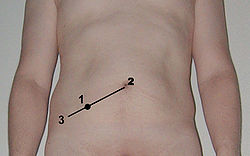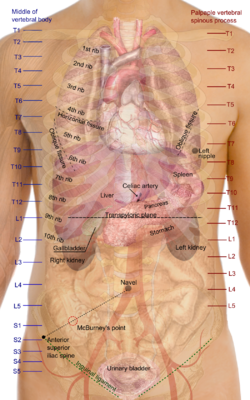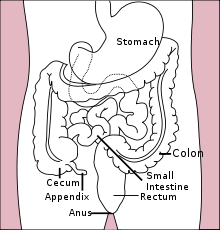- McBurney's point
-
McBurney's point 
Location of McBurney's point (1), located two thirds the distance from the umbilicus (2) to the anterior superior iliac spine (3). 
Surface projections of the organs of the trunk, with McBurney's point labeled with a red circle at bottom left at the inferior part of the cecum. McBurney's point is the name given to the point over the right side of the abdomen that is one-third of the distance from the anterior superior iliac spine to the navel. This point roughly corresponds to the most common location of the base of the appendix where it is attached to the cecum.[1]
Contents
Clinical relevance
Deep tenderness at McBurney's point, known as McBurney's sign, is a sign of acute appendicitis.[2] The clinical sign of referred pain in the epigastrium when pressure is applied is also known as Aaron's sign. Specific localization of tenderness to McBurney's point indicates that inflammation is no longer limited to the lumen of the bowel (which localizes pain poorly), and is irritating the lining of the peritoneum at the place where the peritoneum comes into contact with the appendix. Tenderness at McBurney's point suggests the evolution of acute appendicitis to a later stage, and thus, the increased likelihood of rupture. Other abdominal processes can also sometimes cause tenderness at McBurney's point. Thus, this sign is highly useful but neither necessary nor sufficient to make a diagnosis of acute appendicitis. Also, the anatomical position of the appendix is highly variable (for example in retrocaecal appendix, an appendix behind the caecum), which also limits the use of this sign as many cases of appendicitis do not cause point tenderness at McBurney's point. For most open appendectomies (as opposed to laparoscopic appendectomies), the incision is made at McBurney's point.
Eponym
The sign is named for Charles McBurney (surgeon), U.S. surgeon, 1845–1913.[3]
As a matter of fact McBurney himself did not locate "his" point in such a precise way in his original article.
Experience with early operative interference in cases of disease of the vermiform appendix. New York Medical Journal, 1889, 50: 676-684. Page 678:
The seat of greatest pain, determined by the pressure of one finger, has been very exactly between an inch and a half and two inches from the anterior spinous process of the ilium on a straight line drawn from that process to the umbilicus.
References
- ^ Kyung Won, PhD. Chung (2005). Gross Anatomy (Board Review). Hagerstown, MD: Lippincott Williams & Wilkins. pp. 255. ISBN 0-7817-5309-0.
- ^ "Definition: McBurney's sign from Online Medical Dictionary". http://cancerweb.ncl.ac.uk/cgi-bin/omd?McBurney's+sign. Retrieved 2007-12-06.
- ^ Charles McBurney (www.whonamedit.com)
External links
- Naraynsingh V, Ramdass MJ, Singh J, Singh-Rampaul R, Maharaj D (2003). "McBurney's point: are we missing it?". Surgical and radiologic anatomy : SRA 24 (6): 363–5. doi:10.1007/s00276-002-0069-7. PMID 12652363.
Head Neck Thorax Triangle of auscultation · axillary folds (Anterior, Posterior) · Clavipectoral triangle · Inframammary fold
Infraclavicular fossaAbdomen/pelvis regions (Epigastrium, Hypochondrium, Umbilical region, Latus, Hypogastrium, Inguinal region)
quadrants (RUQ, LUQ, RLQ, LLQ)
McBurney's point · Desjardins' point · Traube's spacePerineal General anatomy: systems and organs, regional anatomy, planes and lines, superficial axial anatomy, superficial anatomy of limbs Categories:- Human anatomy
- Medical signs
Wikimedia Foundation. 2010.

